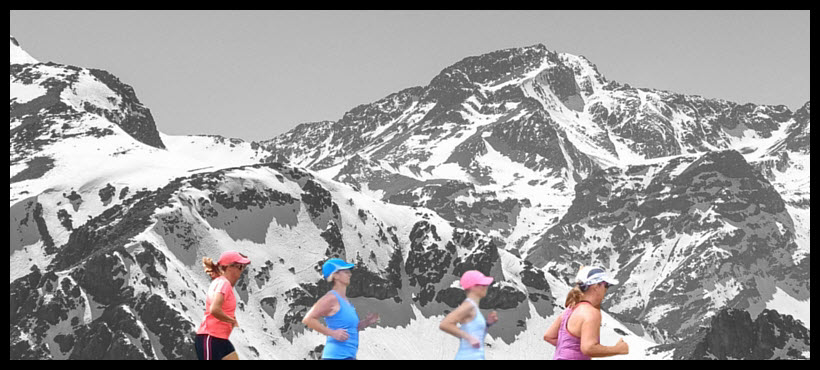
1. Does running in cold weather help you burn body fat?
Seemingly, yes. Cold weather exercising can produce high rates of glycogen depletion, and also high rates of fat metabolism. Glycogen is the form that carbohydrates are stored in the muscles (and other parts of the body) and is a readily available source of energy when you’re working out. There’s a limited amount of glycogen your muscles can store, and once glycogen stores are depleted, your body needs to use more fat for energy.
Exercising in the cold increases glycogen depletion in two ways. Firstly, shivering causes muscles to use glycogen at 5-6 times the normal rate, and cold weather causes elevated blood levels of epinephrine, a hormone which stimulates glycogen breakdown. Epinephrine can also help with fat metabolism.
So, a long run in winter can be a great way to improve body composition and rid yourself of some of those fat stores (as long as you don’t go home and drink gallons of hot chocolate to warm yourself up!)
2. What are goose bumps good for? (and is there a case for hairy legs in winter?)
In modern day humans, goosebumps are pretty much useless. They are an involuntary reaction of the sympathetic nervous system to fear or cold. Muscle contractions raise the hair follicles in our skin, causing that plucked chook look.
Biologists believe that they are a reflex that we developed years and years ago. Our ancestors, who were much hairier than us, may have developed this reaction as part of the fight or flight response, making them appear bigger and scarier when their hair stood up on end. Our more hirsute ancestors would also have been able to trap more heat near their skin with their fluffier body hair. So, I’d say that’s case enough for hairy legs in winter, wouldn’t you?
3. Can you get dehydrated running in cold weather?
Definitely! Cold weather inhibits the thirst sensation because blood moves away from the extremities into the body’s core. Because the core fluid level doesn’t decrease, the kidneys aren’t signalled to conserve fluid. The thirst response can decrease by about 40 per cent in cold weather. When you run in cold weather you still sweat and lose body fluids, so you need to be mindful of drinking more than you might feel you need to.
4. What’s the best temperature for running?
A study from the U.S. Army Research Institute of Environmental Medicine conducted a longitudinal study of results and weather data from six major marathons. They found that colder weather generally meant faster times, with the ideal long-distance running temperature being 5 degrees C. Times slowed progressively as the weather warmed above 5-10 degrees C. Slower runners slowed more than elite runners.
The effect of temperature on your performance is definitely something to keep in mind when you’re planning your next race strategy. I think I’d prefer to settle for a slower time than seek out a marathon to run in 5 degree temps!
5. Why does your nose run in the cold?
The nose warms and humidifies the air you inhale so that it is not too cold for the lungs. If the air is cold and dry, fluid production of the nose increases. If it makes too much fluid, your nose runs. Also, water in warm air condenses in cold air. The air you breathe out of your nose is warm, and when it hits the old air, it could condense at the tip of your nose, forming a very flattering water droplet at the end of your nose.
6. Will you catch a cold if you run in cold weather?
We all know that a cold is a virus, and it makes little sense to say you catch a cold by being cold. You catch a cold by being exposed to a cold virus. Your body also needs to be unable to resist the cold virus to contract a cold. But here’s the thing. Researchers have shown that exposure to cold air enhances the activity of “suppressor macrophages”. These are white blood cells which depress the functioning of the immune system.
So letting yourself get chilled to the bone during a workout can increase your risk of getting sick. The lesson to take from this one is you should wrap up and stay relatively warm. Wear layers you can take off during your session, and always keep something warm and dry on hand for when you finish training. This may mean getting out of damp underlayers as well as outer layers if you have a fair distance to drive before you can warm up in a hot shower.
7. Will exercising mean you get fewer colds in general?
A study published in the British Journal of Sports Medicine in 2008, reported that regular aerobic exercise might reduce the risk of catching a cold by up to 50%. People who exercised at least 5 times per week had up to 46% fewer sick days than those who exercised only one day a week or less. When the exercising group did get sick, their symptoms were milder.
And what of the macrophage suppressing cold weather? On the bright side, the Japanese research found that people who are used to training in cold conditions are less likely to experience the same immune system suppression after running in cold weather than people who only do it now and then. So, don’t shut yourself up during winter. Push through those first cold days of winter, and be consistent with your training as the days get shorter and the nights get colder, and you’ll come out the other side of winter with a stronger immune system.
8. Will running in cold weather give you a heart attack?
Probably not, but there are some studies that have shown an increase in exercise related heart attacks in periods of cold weather. Whilst the jury is out on why cold air should increase your risk of a heart attack, it may be because cold temperatures will raise your heart rate and your arterial blood pressure, which increases the stress on your heart. Also, blood clots more easily in cold weather, which could increase the risk of blocked arteries. Frequent exposure to cold, however, modifies these physiological changes, so again, its most likely the every now and then approach to training that is oh-so-tempting to adopt in winter, is likely to hold the most risk.
And if you’re wondering why your heart rate lifts in cold weather, it’s basically as a result of your body’s efforts to keep you warm. You lose body heat to cold air so your heart rate rises to maintain your core temperature and to keep blood flowing to the brain. Blood vessels in your extremities are restricted, your body burns glucose faster than it does in warmer weather, and you shiver. All of these things require an increased heart rate, so if you’re a heart rate monitor, you’ll likely notice your heart rate is elevated during your next cold weather run. (That is, you’re a person who monitors their heart rate during exercise – I don’t really think one of those Garmin thingys can read…yet)
9. Can running in cold weather make you feel like the temperature is colder than it actually is?
Definitely, but there are ways around this. It’s not just the cold air that makes you cold, but a combination of the cold air and sweat. You don’t stop sweating when you’re exercising in cold weather. You lose heat at a faster rate when your clothing is saturated with moisture. Water conducts heat away from the body 25 times faster than air does, so sweat soaked clothing will give you that chilled to the bone feeling.
Most running gear on the market these days is sweat wicking. Making sure you have a layer of sweat wicking clothing next to your skin when you step out the door for a winter run. Layering up over the top of that will help to stop you from losing too much body heat due to sweat.
10. Can exercising in cold weather give you chilblains?
We were down in Canberra for our boys to play in a soccer tournament. After a less than encouraging start to their first game in the cold, the coaches decided they all needed to toughen up a bit and play without gloves. One boy turned up the next morning with his gloves firmly in place, explaining he had a medical condition called “chilled veins” and his mum said he had to wear his gloves.
Chilblains are patches of red itchy skin. They are thought to be caused by a combination of cold weather and poor circulation, though no-one is 100% sure. If you have poor circulation, you will be more susceptible to chilblains, however if you are a regular exerciser, you’re not so likely to have poor circulation.
Wearing gloves whilst you’re running will keep your hands warm in the cooler weather. You’ll probably find that your hands warm up fairly quickly wearing gloves. If you’re going to need to take your gloves off, do so before your hands become sweaty, otherwise you may well find you give yourself a dose of “chilled veins” when you expose your damp hands to the cold air.
11. What about the wind chill factor?
If there’s a cold wind blowing, you’ll feel the cold even more. A 30km/ hour wind can feel like zero degrees very quickly. Running at 10km an hour into a 20km/hour wind is the equivalent of a 30km/hour wind when you’re standing still, so it doesn’t exactly take a howling gale to make you feel 10 degrees colder.
It’s good idea to run the first part of your run into the wind, so that in the second half of your run, when you’re tired and sweaty, the wind is at your back and the wind chill factor won’t come into play so much. If you run at 10km/hour with the wind behind you at 20km/hr, it’s really like a wind of 10km/hour from the point of view of wind chill. So instead of making it seem 10 degrees colder, the wind will only make it feel about 3-4 degrees colder than the temperature on the thermometer. Cheery thought!
The Bottom Line
Exercising in cold weather can improve your immune system function. It can also put you at a slightly higher risk of catching a cold or having a heart attack, but only it would seem if you aren’t a regular cold weather runner.
Take care to keep hydrated when exercising in winter, layer up, with a sweat wicking layer of clothing closest to your skin, and run in sheltered areas if possible. Where you’re exposed to the wind, try to run with the wind at your back in the latter stages of your run.
Winter is a great time to teach your body to burn fat for fuel on those long runs, as you’ll be using up glycogen more quickly than you would in warmer weather. So cold weather training can leave you well prepared for a great spring racing season.


